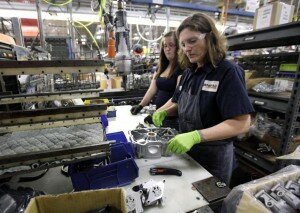 A buzzword in the manufacturing industry today is the “gender gap”: the disparity between males and females in manufacturing occupations throughout the United States. That’s not to say that there aren’t female-dominated occupations, because there certainly are, but manufacturing has traditionally been construed as a male-dominated occupation.
A buzzword in the manufacturing industry today is the “gender gap”: the disparity between males and females in manufacturing occupations throughout the United States. That’s not to say that there aren’t female-dominated occupations, because there certainly are, but manufacturing has traditionally been construed as a male-dominated occupation.
And with some of these statistics from recent appraisal of male- vs. female-dominated occupations, it’s easy to see why. For example, only 0.3% of mining machine operators are women, 0.8% of tool and die operators are women, and 1.2% of automotive service technicians are women. The number is a bit higher for operating engineers and other construction equipment operators at 1.3%, but that still only equates to about 385,000 women in the United States.
The numbers are also at 1% or below for heavy vehicle and mobile equipment service technicians and mechanics, brick masons, bus and truck mechanics, and diesel engine specialists. On the other end of the spectrum, 95.3% of secretaries and administrative assistants are women, and 94.1% of childcare workers are women. As much as we’d like to think that in 2015 we live in a modernized culture, there are still stereotypes and assumptions about jobs for women that trickle down to career levels.
These types of numbers that firmly establish a gender gap between manufacturing and other careers are part of what some organizations around the world are attempting to change. How can we, as a culture, work together to refresh and revitalize notions of how one’s gender could or should be associated with one’s career?
Here are a few organizations and people we’ve found working to do just that. Are there any we missed? Leave a comment in the section below, anytime!
This is actually a two-in-one feature, as Denisse’s story was told by Broadly, a female-focused offshoot of Vice. Broadly recently began a campaign to spend “A Day With” women in workplaces traditionally dominated by men. Their first video highlighted Denisse Arranda, one of the top engineers at NASA Langley Research Center. The video exposes Arranda as a real human being who likes fast cars and is a transplant from Venezuela.
It also exposes some of the difficulties for women in engineering. “Any woman in the engineering field … always has to be so much better,” says Arranda. Despite the challenges, though, she’s passionate about the work she does at NASA: “We really are civil service. We don’t get the most publicity, we don’t get recognized, but there’s not a single thing you have touched this day that we do not influence.”
This year, Sargeant, a production supervisor at Caterpillar, Inc., was recognized by the STEP Ahead Awards from the Manufacturing Institute, designed to honor successful women in manufacturing. “Manufacturers need to start early and promote programs to get engineering in front of young women,” says Sargeant.
When asked what she would tell young women interested in manufacturing, Sargeant says, “Go for it! And explore—there are so many opportunities available in STEM. Learn as much as you can about the career you are interested in, and find the right fit.”
Ansari is an astronaut, engineer, and entrepreneur who was the first Muslim woman to travel to space as a tourist. She didn’t speak any English when she moved to America at age 18 (she is now based in Texas) but today is the cofounder and head of Prodea, a tech company focusing on IoT.
“I have all the things that could give me a disadvantage on an application. It’s not just being a woman, but being born in Iran … I have to go through the additional process of educating people.”
Do you know any other women redefining labels in male-dominated occupations? If so, leave a comment in the section below—we’d love to hear about them!
—
Photo credit:
 Official Nebraska Government Website
Official Nebraska Government Website
